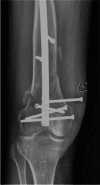Rates of interlock screw back-out are high with the retrograde femoral nailing advanced system for distal femur fractures
- PMID: 38806688
- PMCID: PMC11377647
- DOI: 10.1007/s00590-024-04006-5
Rates of interlock screw back-out are high with the retrograde femoral nailing advanced system for distal femur fractures
Abstract
Purpose: The retrograde femoral nailing advanced (RFNA) system (DePuy synthes) is a commonly used implant for the fixation of low distal femur and periprosthetic fractures. There is concern that the rate of distal interlock screw back-out may be higher for the RFNA compared to other nails (ON). The purpose of this study was to evaluate the incidence of interlock screw back-out and associated screw removal for RFNA versus ON, along with associated risk factors.
Methods: A retrospective comparative study of patients who underwent retrograde nailing for a distal femur fracture at an academic level one trauma center was performed. The incidence of distal interlock screw back-out and need for screw removal were compared for RFNA versus a propensity score matched cohort who received other nails.
Results: One hundred and ten patients underwent retrograde nailing with the RFNA for a distal femur fracture from 2015 to 2022 (average age: 66, BMI: 32, 52.7% smokers, 54.5% female, 61.8%). There was a significantly higher rate of interlock back-out in the RFNA group compared to the ON (27 patients, 24.5% vs 12 patients, 10.9%, p = 0.01), which occurred 6.3 weeks postoperatively. Screw removal rates for back-out were not significantly different for the RFNA group versus ON (8 patients, 7.3% vs 3 patients, 2.7%, p = 0.12).
Conclusion: In this retrospective comparative study of distal femur fractures treated with retrograde nailing, the RFNA implant was associated with an increased risk of distal interlock screw back-out compared to other nails.
Keywords: Distal femur fracture; Femoral nail; Intramedullary nail; Retrograde femoral nail; Retrograde femoral nailing advanced.
© 2024. The Author(s).
Conflict of interest statement
Author RB declares that he has no conflict of interest. Author STC is a member of an OTA committee. Author EF declares that she has no conflict of interest. Author GS is a member of an OTA committee, AO Trauma North America committee, and is a paid consultant for DePuy Synthes, a Johnson & Johnson company A. Author MAL is a board member of AO Trauma North America, receives IP royalty from Globus Medical, owns stock in Osteocentric, is a paid consultant for Osteocentric, and is a paid consultant for DePuy Synthes, a Johnson & Johnson company. Author AMS is a member of an OTA committee, ORS committee, AAOS committee, and AO North America committee.
Figures


Similar articles
-
Comparison of the RFN-advanced femoral nailing system versus locked lateral plating in the management of distal femur fractures: A matched-cohort analysis.Injury. 2025 Aug;56(8):112442. doi: 10.1016/j.injury.2025.112442. Epub 2025 May 30. Injury. 2025. PMID: 40446568
-
Distal locking screw migration in the depuy-synthes retrograde femoral nail-advanced-an unexpected consequence of an implant upgrade.Injury. 2025 Apr;56(4):112265. doi: 10.1016/j.injury.2025.112265. Epub 2025 Mar 13. Injury. 2025. PMID: 40121859
-
Early Complications of a Novel Retrograde Intramedullary Femoral Nail in the Treatment of Femur Fractures.J Orthop Trauma. 2024 Jun 1;38(6):333-337. doi: 10.1097/BOT.0000000000002804. J Orthop Trauma. 2024. PMID: 38478429
-
The geriatric distal femur fracture: nail, plate or both?Eur J Orthop Surg Traumatol. 2023 Jul;33(5):1485-1493. doi: 10.1007/s00590-022-03337-5. Epub 2022 Jul 27. Eur J Orthop Surg Traumatol. 2023. PMID: 35895117 Review.
-
[Borderline indications for locked intramedullary nailing of femur and tibia].Orthopade. 1996 Jun;25(3):234-46. Orthopade. 1996. PMID: 8766662 Review. German.
References
-
- Coon MS, Best BJ (2022) Distal femur fractures. StatPearls Publishing, StatPearls - PubMed
Publication types
MeSH terms
LinkOut - more resources
Full Text Sources
Medical
Miscellaneous

